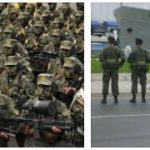Ecuador is a South American country. Bathed by the Pacific to the west, it is limited to the north by Colombia and to the east and south by Peru. Ecuador covers a total area of 283 560 km2 , including the Galapagos archipelago (7 844 km2 ), located in the Pacific Ocean about 1,100 km west of the Ecuadorian coast.
The main cities are Guayaquil, with 2 044 700 residents (2004), Quito, the capital (1 466 300 residents), And Cuenca (290 1 00 residents). Forests cover about 40% of the total area of the territory. Two Andean mountain ranges cross the country from north to south and divide it into three different areas. The coastal plain where 32% of the population lives has a tropical climate in the north and very dry in the south. The La Sierra region is formed by two massifs, between which a depression of 2 800 m extends; this is where the capital, Quito, is located, where 60% of Ecuador’s residents reside. It is a temperate climate area. The top of the two mountain ranges is marked by the cones of 51 volcanoes, many of which are active. The third area of relief is the Amazonian plain, it has a hot and humid climate, being covered with tropical forests;
Climate
In the eastern part of the country, the climate is equatorial; in the Andes, the climate is high, with low temperatures throughout the year; on the coast, there is a semi-desert strip to the south, and an area of humid tropical climate to the north.
Economy
Ecuador’s economy is based primarily on agriculture. In the Andean region, barley, potatoes, corn and beans are produced. In the coastal region, rice, cocoa, coffee, bananas and other tropical fruits are grown for export. Fishing is also an important activity. The main industry is the textile. Ecuador’s main trading partners are the United States of America, Colombia, Japan and Venezuela.
Environmental indicator: the value of carbon dioxide emissions, per capita, (metric tons, 1999) is 1.9.
Population
The population is 13 547 510 residents (2006), which corresponds to a population density of 47.13 residents/km2. The birth and death rates are, respectively, 22.29% and 4.23%. Average life expectancy is 76.42 years. The value of the Human Development Index (HDI) is 0.731 and the value of the Gender-adjusted Development Index (IDG) is 0.716 (2001). The population consists of Amerindians (25%), mestizos (65%), whites (7%) and blacks (3%). The religion practiced by the vast majority of the population is Catholic (93%). The official language is Castilian.
History
The current territory of Ecuador has been part of the Inca Empire since its conquest by Pizarro in 1532. This country proclaimed its independence in 1809, following a revolutionary movement, but it was in 1822 that General Sucre would conquer the Spanish. On May 13, 1830, a free and independent republic was proclaimed. A period followed alternately by conservatives and liberals and generals. Ecuador’s history was marked by the cruel and tyrannical dictatorship of Gabriel García Moreno who was eventually murdered in 1875. The next twenty years were of struggle between conservatives and liberals and the coups d’état did not stop happening. In 1930 a revolution broke out in Quito, which left 200 dead. Until the 1960s, Ecuador lived in a climate of political instability. In 1968, conservatives, Liberals and socialists prepared elections in a climate of violence. In 1972, the Republic of Ecuador already had 50 coups d’état.
In 1973, hydrocarbon deposits were discovered, making Ecuador one of the largest oil producers in South America. This discovery allowed the development of the economy and politics of the country that, for the first time, elected a two-headed executive. The neoliberal philosophy, which inspired an economic policy, resulted in the opening of borders. Traditional cultures and fishing developed and in 1987 it was the world’s first shrimp exporter. Despite oil being a guarantee of prosperity, inflation remained high and led to currency devaluation and the worsening living conditions of the majority of the population. The minimum wage is the lowest in Latin America and to this is added health problems related to malnutrition. For Ecuador democracy and rights, please check localbusinessexplorer.
- Countryaah.com: Offers a full list of airports in the country of Ecuador, sorted by city location and acronyms.
- Abbreviationfinder.org: Provides most commonly used abbreviations and initials containing the country name of Ecuador. Listed by popularity.
1UpTravel.com – Maps of Ecuador
Check out the city, shaded relief and political maps of this South American country, bordering the Pacific Ocean at the Equator. View the maps of Quito and Guayaquil.
Website: http://www.1uptravel.com/worldmaps/ecuador.html
Ecuador – Infoplease Map
Peruse a map of this small South American country. Locate cities and towns throughout the country, plus river systems and bordering countries.
Website: http://www.infoplease.com/atlas/country/ecuador.html
Ecuador – National Geographic Map Machine
Located cities and towns throughout Ecuador with this dynamic map. Features include zooming, map moving and even map saving.
Website: http://plasma.nationalgeographic.com/mapmachine/index.html?i
MSN Encarta Maps – Ecuador
Interactive color map of Ecuador allows visitors to click on cities, towns and parklands to get more information and resources. From Microsoft.
Website: http://encarta.msn.com/maps/mapview.asp?mi=T628143A&ms=0


